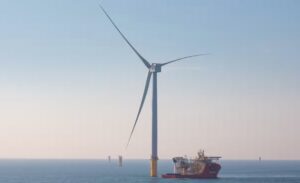UPDATED: New federally funded research investigating the association of wind farm noise with adverse effects on humans has found that the “swoosh” sound made by spinning turbine blades was likely to be more noticeable – and more annoying – to nearby residents during the night than during the day.
The research, led by Flinders University PhD candidate Duc Phuc Nguyen and acoustic expert Dr Kristy Hansen, has combined long-term monitoring of wind farm noise with machine learning to quantify and characterise the noise produced by wind turbines.
The resulting two new publications mark the latest findings in the five-year Wind Farm Noise study that was funded by the federal government’s National Health and Medical Research Council, with funding also supplied through Australian Research Council grants.
The Wind Farm Noise Study, based at the Adelaide Institute for Sleep health at Flinders University, is investigating noise characteristics and sleep disturbances at residences located near wind farms, to inform what the researchers describe as the “ongoing debate” around turbine noise and adverse effects on human health.
Claims that wind turbine noise – both those sounds that are detectable to the human ear and the “infrasound” that is undetectable – can affect the health and well-being of humans (and animals) have have indeed sparked much passionate and sometimes pretty sensational discussion within and without the renewable energy industry.
In May 2012, the Murdoch media entertained claims that South Australia’s Waterloo Wind Farm might be causing mutations of chicken embryos, spikes in “sheep deformities” and “erratic behaviour by farm dogs.”
But as Ketan Joshi reported here in 2013, an EPA investigation into the Waterloo claims found the project’s noise levels complied with its guidelines, and that noise resulting from other environmental sources – such as the actual wind – were often louder than the turbines. The EPA also found that residents were reporting noise issues from the wind farm during periods that the turbines were shut down.
To date, there is little credible scientific evidence to support the claim that wind turbine noise in and of itself causes people to become unwell. Rather, European studies have found that between 5 and 20 per cent of people living near wind farms can be annoyed to varying degrees by turbine noise.
The degree of annoyance tends to be much higher in people if the turbines are in their line of sight, if the complainants are not being paid for hosting turbines on their land, or if they believe the authorities have treated them unfairly.
In the same vein, Dr Hansen, an “acoustic expert” who has has spent the better part of a decade studying various types of wind farm noise, said the new studies had advanced the team’s ability to measure and monitor turbine noise that was “likely to be more annoying than other noise types at the same level.”
One such annoying noise was the turbines’ night-time “swoosh” sound, technically referred to as “amplitude modulation” (AM), which the studies determined were likely to be heard by neighbouring residents “up to five times more often” than during the day, depending on wind direction, season and wind farm distance.
“We found that the amount of amplitude modulation present during the daytime versus night-time varies substantially occurring two to five times more often during the night-time compared to the daytime,” said Nguyen, who is based at the university’s Institute for Sleep Health.
“The noise seems to worsen after sunset when amplitude modulation can be detected for up to 60% of the night-time at distances around 1km from a wind farm. At greater than 3km, amplitude modulation also occurs for up to 30% of the night-time.”
Hansen added that the directional nature of wind turbine noise meant that residents living in downwind and crosswind conditions were likely to be more disturbed by wind turbines.
“We found that AM occurs most often during these wind directions. Using these recent advances in machine learning, we have been able to develop an AM detection method that has a predictive power close to the practical limit set by a human listener.
“This includes the noise that increases and decreases as the blades rotate, or AM, including a ‘swoosh’ sound, which further contributes to the negative effects of wind turbine noise.”
What those “negative effects” the swooshing sounds are said to be further contributing to is not made clear, and a request for more information from Hansen and Nguyen had not received a response in time for publication. (Editor’s Note: A response emailed post publication has been published in full at the end of this article.)
But as Professor Peter Catcheside from Flinders University’s Adelaide Institute for Sleep Health explained in an interview in 2018, the study is focusing on the sleep elements of the debate.
“We think if there are adverse health effects, the most likely explanation for those would be through sleep disturbance and really no-one has looked in enough detail at sleep specifically,” he told the ABC.
As to why wind turbine noise was “likely to be more annoying that other noise types at the same level” Hansen gave an explanation of sorts in the same 2018 ABC article:
“So like if you’re in a hotel, a very cheap hotel, and there’s a noisy refrigerator in there and it’s humming and then not only is that noise annoying because it’s a hum, but then imagine if someone starts switching it on and off every second,” she said.
“That’s the kind of noise we are talking about – so even if the noise is not particularly loud just because of the nature of that noise it makes it particularly annoying.”
Whatever this means, and however you might measure the relative annoying-ness of night noises and their resulting impact on sleep, and then in turn on human health, the researchers believe this is important progress.
They say the studies take another step towards improving wind turbine noise assessment methods, wind farm development guidelines, and wind turbine design to make wind energy more acceptable to surrounding communities.
This is no small issue. The vital importance of building social licence for both wind and solar projects is coming into ever sharper relief as the shift to renewables in Australia gathers pace – and developers ignore it at their peril and the industry’s shame.
On the plus side, it seems like there might be some fairly straight-forward ways for developers to address the problem of these annoying swooshy noises. Making sure nearby households are more than 3km away from any one wind turbine is just one obvious – and already routinely implemented – solution. For those feeling annoyed, wearing earplugs to bed might be another.
It also begs the question of who should be held to account for health problems related to lack of sleep due to the repetitive low-frequency hum of the federal government’s stubborn refusal to take the threat of dangerous climate change seriously while the world literally burns. Now that is annoying.
UPDATE: A response from Dr Kristy Hansen and Duc Phuc Nguyen was emailed to RenewEconomy on Friday morning and is published in in full below…
RE: Dr Hansen… you note that the nighttime swoosh sound “further contributes to the negative effects of wind turbine noise.” Can you elaborate on this? What are those “negative effects” of wind turbine noise?
The negative effects of wind turbine noise include subjectively reported psychological distress, stress, and difficulties to fall asleep and sleep interruption. At Flinders University, we are now investigating whether wind turbine noise could affect sleep quality using objective measurements. We hope to establish whether negative effects of wind turbine noise can be measured objectively in the near future.
RE: You also note that the studies have advanced your ability to measure and monitor wind turbine noise that is “likely to be more annoying than other noise types at the same level.” Can you explain why it is likely to be more annoying than, say, the noise of cows mooing or cars passing on roads?
This statement is based on a cross-sectional study performed in Sweden in 2000. The authors compared four different types of noise and found that at the same level the most annoying noise was wind turbine noise followed by aircraft, road traffic and railway noise respectively.
The unique characteristics of wind turbine noise are likely to contribute towards annoyance. For example, the noise is dominant at low-frequencies (low pitch sound). It also has a varying noise level (loud-quiet rhythm) that is referred to as amplitude modulation. Another important factor is that ambient noise levels are relatively low in
rural areas surrounding wind farms, particularly at night-time.
Conversely, wind turbine noise can be more distinguishable at night-time due to atmospheric effects. On the other
hand, road traffic noise is usually quieter at night-time when people are trying to sleep.
In short, wind turbine is likely to be more annoying than other noise sources because of its characteristics and other non-acoustic factors such as atmospheric effects and timing of worst-case noise exposure.
RE: How serious are the implications of this? What sort of impacts could an annoying noise have on people’s sleep and overall well-being?
In this particular study, we investigated the prevalence of wind farm noise amplitude modulation. We did not report on the effects of the amplitude modulation on sleep or well-being. We will be able to provide more information on the effects of wind farm noise on sleep in future analyses that are currently ongoing.
RE: Is it possible some people could be affected worse than others by this phenomenon, depending on their overall feelings about wind turbines or a particular wind farm project?
It is possible. The perception of sound substantially varies between humans. The most obvious factor is variations in the hearing threshold which can make humans perceive the sound differently. Other factors, as you mentioned, include overall feelings, noise sensitivity and attitude towards wind farms, which can also vary between residents.
We do not have comprehensive data to conclude whether a particular wind farm project is more annoying than another project. However, it is true that different types of wind turbines and wind farm configurations can make the noise worse at particular locations.







